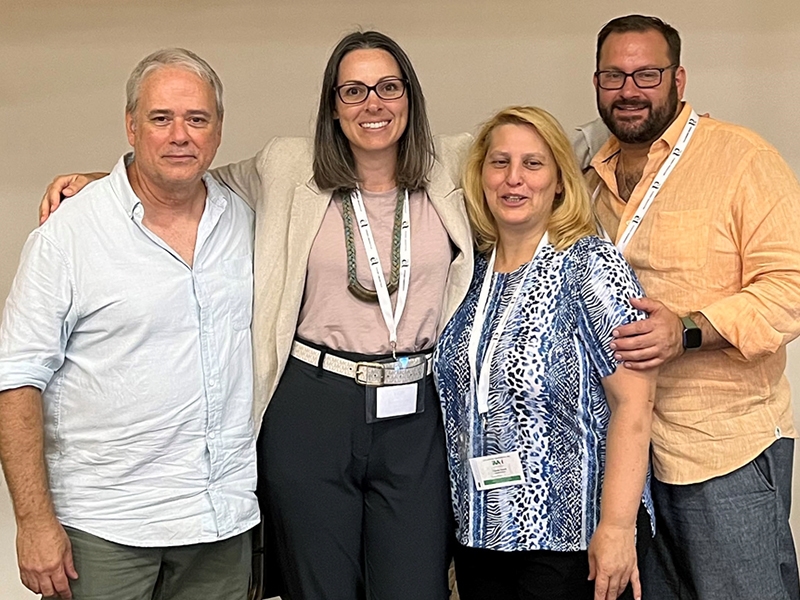
As part of the 100th Anniversary Convention of the American Association of Teachers of Italian, held July 5-8 in Catania, Sicily, faculty from the Department of World Languages, Literatures, and Cultures combined to present a panel on "Gaming the Mediterranean: Teaching and Researching through Virtual Reality."
Assistant professor Rhodora Vennarucci ("The Virtual Roman Retail Project: Developing Digital Archaeology Pedagogy for the Classroom'') focused on the incorporation of digital workflows for archaeological visualization into an upper-level honors colloquium on ancient shopping, marketing history, and consumer behavior. In particular, Vennarucci's students learned how to use photogrammetry software (Agisoft's Metashape) to process photosets from Ostia Antica (ancient Rome's harbor city) into 3D models of shop features (basins, counters, thresholds) that they then published on SketchFab. They also worked in collaborative teams to produce podcasts for the "Shop Til' You Drop" series published on Anchor that addressed and interpreted the experience of shopping in Roman antiquity. Finally, each student designed and decorated their own ancient retail space, using a variety of 3D software packages. The exit surveys from Vennarucci's class confirmed that through these High-Impact Practices (HIPs) students left the class with a level of digital literacy and confidence using 3D software that they did not have at the beginning of the semester.

A still image from the Insta360 Pro2 shows the Circus Mosaic from the Villa Romana del Casale, a UNESCO World Heritage Site in Piazza Armerina, Sicily.
Associate professor David Fredrick ("Hearts of Lead: A VR Mystery Game to Teach Ancient Roman Culture") outlined the development of a prototype virtual-reality game set in Ostia Antica, designed to teach students the importance of guilds and economic mobility in ancient Roman cities while immersing them in the interconnected realms of magic and religion in everyday Roman life. Under development by a small student team at U of A — Michael Hall, Ph.D. student in comparative literature; Ben Kinser, undergraduate senior in computer science; Meg McCartney, undergraduate senior in sculpture and experimental media (SculX) — "Hearts of Lead" creates its game-play spaces by combining 360-degree still images of settings in Ostia with spherical reconstruction drawings of how the setting looked in antiquity. Game play itself is focused on the manipulation of body residue, a curse doll, a lead curse tablet, and the timely intervention of the goddess Isis to resolve a potentially disastrous conflict within the powerful guild of barge boat operators in Ostia's harbor.
 Mitchell Simpson, a doctoral student in English, sets up the Insta360 Pro2 camera in the ancient Theater at Segesta, Sicily.
Mitchell Simpson, a doctoral student in English, sets up the Insta360 Pro2 camera in the ancient Theater at Segesta, Sicily.
Associate professor Ryan Calabretta-Sajder and instructor Claudia Devich ("Exploring the Mediterranean from Home: Learning Italian Language and Culture through VR") presented their innovative approach to incorporating immersive learning through VR into the Italian language program. Working initially with professor Fredrick and the Tesseract Center on the U of A campus, and then with Causeway Studios, Calabretta-Sajder and Devich developed interactive modules set within 360-degree captures of the Mercato dell'Unità and a teaching kitchen in Trastevere (both in Rome) to teach the vocabulary of food and cooking, as well as grammar concepts like the use of the imperative. While technical rough spots still need to be addressed, course exit surveys document that for the majority of students the VR modules contributed significantly to their ability to learn and retain the content.
Calabretta-Sajder, current president of American Association of Teachers of Italian, organized the "Gaming the Mediterranean" panel in coordination with a complementary project in WLLC, "Mediterranean 360." Through this project, faculty from the U of A, including professors Fredrick, Curtis Maughan and Manuel Gobante, and doctoral students Rachel Murray and Mitchel Simpson, collaborated with faculty from the University of Manouba, Tunis, to accomplish 360-degree photography of sites in Tunisia and Sicily, and exploratory visits to sites in Spain, from June 16-July 3. Captured with an Insta360 Pro 2 camera rig, the 360-degree photography will be used as the basis for producing interactive, accessible virtual tours and game-based applications to teach the cross-cultural history of the ancient and medieval Mediterranean. Once the sites have been captured in their current condition, spherical reconstruction drawings by a small team of artists can be layered on top of the images to suggest how the site looked at a given historical moment. The 360-degree images and reconstruction drawings can then be imported into the game engine Unity3d, allowing the creation of interactive tours and game-based applications. Working in collaborative teams, U of A graduate and undergraduate students will have a direct role in producing these applications, and thus "Mediterranean 360" is a significant example of high-impact practices at the University of Arkansas.
Topics
Contacts
Cheyenne Roy, assistant director
Language Lab and Digital Humanities
479-575-4159, ceroy@uark.edu